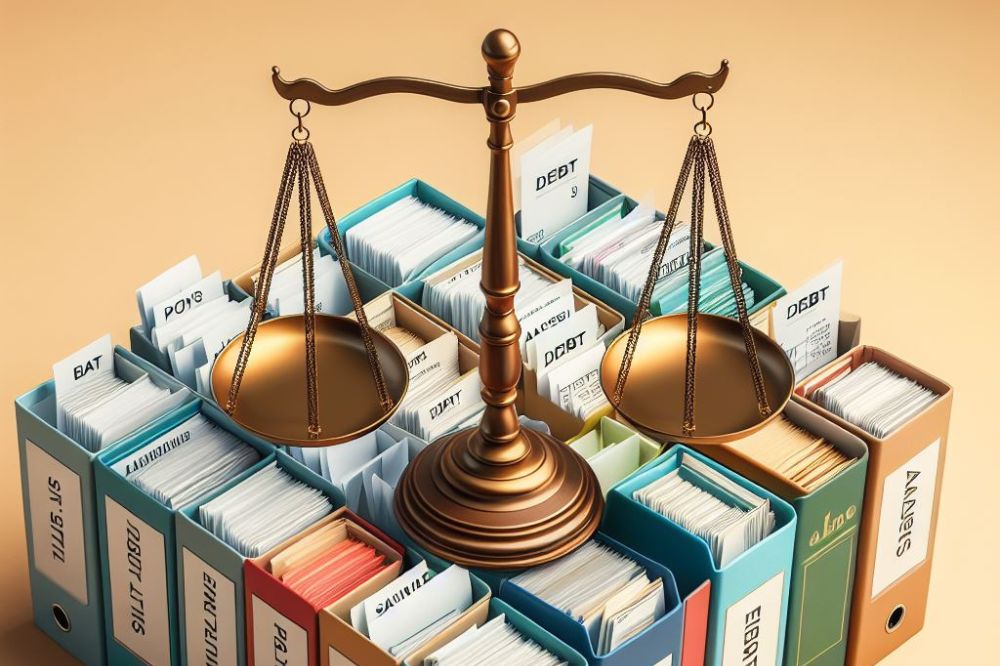- Understanding Bankruptcy
- Eligibility Criteria
- Preparing for Bankruptcy
- Filing Process Explained
- Life After Bankruptcy
- Alternatives to Bankruptcy
- Common Misconceptions
- Legal Considerations
- Case Studies and Examples
- Final Remarks
- Frequently Asked Questions
Exploring the fundamentals of bankruptcy can be both daunting and enlightening. Understanding the contrast between liquidation and reorganization, as well as the impact on assets and liabilities, is crucial. Delving into the intricacies of Chapter 7 versus Chapter 13 bankruptcy sheds light on individual debt relief options.
Navigating the complexities of bankruptcy law requires a grasp of exemptions, dischargeable debts, and repayment plans. Unraveling the jargon surrounding bankruptcy filings unveils a path towards financial recovery, help, and a fresh start. Embracing this knowledge empowers individuals to make informed decisions about their financial future.
Understanding Bankruptcy

Definition
Bankruptcy is a legal process that helps individuals and businesses file to eliminate or repay their debts through court protection. It aims to provide a fresh start financially by either restructuring debts or liquidating assets. When someone files for bankruptcy, they are protected from creditors’ collection attempts.
Types
Chapter 7
Chapter 7 bankruptcy involves the liquidation of assets to pay off debts. It is designed for individuals with little to no disposable income. Once filed, an automatic stay prevents creditors from collecting debts. Qualification for Chapter 7 is based on the means test, which assesses income and expenses.
Chapter 13
Chapter 13 bankruptcy allows individuals to restructure their debts through a repayment plan lasting three to five years. This chapter is suitable for those with a regular income who want to keep their assets while catching up on missed payments. Eligibility criteria include having a steady income and debt below certain limits.
Chapter 11
Chapter 11 bankruptcy primarily applies to businesses seeking to reorganize their operations and finances. It allows companies to continue operating while developing a plan to repay creditors over time. Despite its advantages in preserving businesses, Chapter 11 is complex and costly due to its detailed reporting requirements.
Process Overview
The bankruptcy process begins with filing a petition in court. The court appoints a trustee to oversee the case and holds meetings with creditors. Debtors must attend credit counseling before filing and complete a financial management course after filing.
Importance
Bankruptcy serves as a crucial tool for debt relief when individuals or businesses face overwhelming financial burdens by filing. It offers a legal way to address debts that cannot be repaid, providing an opportunity for a fresh start. While it may have negative consequences such as impacting credit scores, filing bankruptcy can ultimately lead to financial recovery.
Eligibility Criteria
Individual Filing
Filing for bankruptcy as an individual involves a detailed process that starts with gathering financial documents. Completing the required forms accurately is crucial for a successful filing process. Understanding the differences between Chapter 7 and Chapter 13 is essential. Chapter 7 typically involves liquidating assets to pay off debts, while Chapter 13 focuses on creating a repayment plan.
Individual bankruptcy can have significant implications on personal assets. Assets like homes, vehicles, and savings may be at risk during bankruptcy proceedings. It’s important to consult with a bankruptcy attorney to understand how to protect your assets.
Business Filing
Businesses considering bankruptcy must weigh various factors before filing. Understanding the type of bankruptcy that suits the business structure is crucial. The impact of business bankruptcy extends to stakeholders such as employees, suppliers, and shareholders. Communication and transparency are key during this process.
When a business files for bankruptcy, it can explore restructuring options to stay operational. These options include debt reorganization, asset sales, or mergers. Seeking professional advice from financial advisors or attorneys can help in navigating these complex decisions.
Means Test
The means test is a critical requirement for determining bankruptcy eligibility based on income levels. It assesses whether an individual or business has enough disposable income to repay debts. For individuals, passing the means test determines qualification for Chapter 7 or Chapter 13 bankruptcy.
Income thresholds play a significant role in determining if an individual or business passes the means test. Meeting these thresholds indicates eligibility for Chapter 7 bankruptcy, where debts are typically discharged quickly. For those above the threshold, Chapter 13 provides a structured repayment plan.
Preparing for Bankruptcy
Documentation Needed
Gathering essential documentation is crucial before filing for bankruptcy. This includes proof of income, assets, debts, and expenses. Accurate financial records are vital to support the bankruptcy petition. Without proper documentation, the process may be delayed or denied.
Having all necessary documents in order helps ensure a smooth bankruptcy filing. Proof of income can include pay stubs or tax returns. Asset documentation involves listing properties and valuables owned. Debt records detail outstanding loans or credit card balances. Expense records outline monthly bills and living costs.
Documentation plays a pivotal role in supporting the bankruptcy petition. It provides a clear picture of the debtor’s financial situation and helps determine the appropriate type of bankruptcy to file. Accurate records also demonstrate transparency and honesty to the court during the legal proceedings.

Credit Counseling
Credit counseling is a mandatory step in the bankruptcy process. It involves meeting with a certified counselor to review finances and create a budget plan. The counselor helps debtors understand their financial situation better and offers guidance on managing debts effectively.
Through credit counseling, debtors can learn about budgeting strategies and responsible financial habits. This empowers them to make informed decisions regarding their money matters and avoid falling back into debt after bankruptcy. Counseling sessions aim to improve financial literacy and promote long-term financial stability.
Engaging in credit counseling before filing for bankruptcy is beneficial as it equips individuals with the knowledge needed to make sound financial choices post-bankruptcy. By learning effective money management skills, debtors can rebuild their credit scores and work towards a more secure financial future.
Hiring an Attorney
Hiring a skilled bankruptcy attorney is essential when navigating the complex legalities of bankruptcy filings. An attorney provides expert guidance on the best course of action based on individual circumstances, ensuring all legal requirements are met throughout the process.
A bankruptcy attorney serves as an advocate for debtors, representing their interests in court proceedings and negotiations with creditors. They offer invaluable legal advice on how to protect assets, discharge debts, and achieve a favorable outcome in bankruptcy cases.
The benefits of legal representation in bankruptcy cases are vast, including peace of mind knowing that an experienced professional is handling the legal complexities involved in the process. Attorneys can help debtors understand their rights, explore available options, and navigate through challenging legal procedures effectively.

Filing Process Explained
Submitting the Petition
Submitting a bankruptcy petition involves filling out and filing the necessary forms with the court. The petition typically includes personal financial information, such as income, expenses, assets, and debts. Accuracy in the petition is crucial as inaccuracies can lead to legal consequences.
Automatic Stay
The automatic stay provision in bankruptcy immediately halts creditor collection efforts, including lawsuits, wage garnishments, and foreclosure proceedings. This protection gives debtors breathing room to reorganize their finances without constant creditor harassment. However, there are exceptions to this rule, such as for criminal proceedings or certain types of debts.
Meeting of Creditors
The meeting of creditors, also known as a 341 meeting, is a mandatory hearing where the debtor must answer questions under oath from the bankruptcy trustee and any creditors present. The trustee’s role is to oversee the process, ensuring compliance with bankruptcy laws. Debtors must provide accurate information during this meeting.
Discharge of Debts
Debt discharge is the ultimate goal of most bankruptcy cases, where qualifying debts are eliminated. Types of debts that can be discharged include credit card balances, medical bills, and personal loans. Once debts are discharged, debtors are no longer legally obligated to repay them, providing a fresh start for their financial future.
Life After Bankruptcy
Credit Impact
Bankruptcy significantly impacts credit scores, leading to a sharp decline post-filing. This decline can last for several years. Future borrowing becomes challenging due to the tarnished creditworthiness resulting from bankruptcy. Rebuilding credit post-bankruptcy requires time, effort, and strategic financial planning.
Recovery Steps
Budgeting
Budgeting plays a crucial role during and after bankruptcy. It helps individuals track their expenses, prioritize payments, and avoid accumulating more debt. By creating a budget, individuals can regain control over their finances and prevent future financial difficulties. Tips include setting strict spending limits, tracking expenses diligently, and prioritizing essential payments.
Rebuilding Credit
To rebuild credit after bankruptcy, individuals must adopt responsible credit use practices. This involves making timely payments, keeping credit card balances low, and avoiding new debts. Utilizing secured credit cards or becoming an authorized user on someone else’s account are common strategies to rebuild credit. Various credit-building tools and resources cater specifically to those who have filed for bankruptcy.
Long-term Effects
Bankruptcy’s long-term effects extend beyond the initial filing period. It can impact an individual’s financial stability for years to come, affecting future loan approvals and interest rates. Making major financial decisions post-bankruptcy requires careful consideration due to the lingering effects of the filing. Strategies to mitigate these long-term effects include establishing an emergency fund, seeking financial counseling, and consistently monitoring credit reports.
Alternatives to Bankruptcy
Debt Settlement
Debt settlement involves negotiating with creditors to pay off a portion of what you owe, typically in a lump sum. This differs from bankruptcy, where debts may be discharged entirely. While bankruptcy offers a fresh start, debt settlement can save your credit score from the severe hit bankruptcy causes.
On one hand, debt settlement allows you to avoid the long-term negative impact of bankruptcy on your credit report. However, it can also lead to tax consequences as forgiven debts are considered taxable income. Debt settlement often results in paying less than what you owe but requires a lump sum payment.
In situations where you have some disposable income and want to avoid the stigma of bankruptcy, debt settlement could be a viable option. It is suitable for individuals with unsecured debts like credit cards and medical bills who can negotiate with creditors.
Consolidation Loans
Consolidation loans combine multiple debts into a single loan with a lower interest rate, simplifying monthly payments. This approach helps in managing debt by streamlining payments into one manageable amount each month.
One benefit of consolidation loans is the potential for lower interest rates compared to credit cards or other debts. However, there is a risk of accumulating more debt if spending habits are not adjusted after consolidating debts. It is crucial to address the root cause of debt accumulation to prevent future financial challenges.
While consolidation loans offer convenience and potentially lower interest rates, they are not suitable for everyone. Some individuals may find it challenging to qualify for favorable loan terms based on their credit history or income levels. Alternatives like creating a strict budget or seeking assistance from non-profit credit counseling agencies may be more appropriate.

Credit Counseling
Credit counseling involves working with financial experts to create a personalized plan for managing debt and improving financial health. These professionals provide guidance on budgeting, debt repayment strategies, and financial education.
One key advantage of credit counseling is the tailored approach to addressing individual financial challenges. Moreover, credit counselors can negotiate with creditors on behalf of clients to reduce interest rates or waive fees, making debt repayment more manageable.
Engaging in credit counseling can help individuals develop better money management skills and gain insights into effective debt repayment strategies. By learning how to budget effectively and make informed financial decisions, individuals can work towards achieving long-term financial stability.
Common Misconceptions
Losing Everything
Bankruptcy doesn’t mean losing everything. Protections and exemptions safeguard certain assets from liquidation during bankruptcy proceedings. These safeguards ensure that individuals can retain essential belongings such as a primary residence, vehicle, and personal items.
Contrary to popular belief, bankruptcy offers a fresh start by eliminating overwhelming debt while allowing individuals to maintain crucial possessions. This process aims to provide financial relief without stripping individuals of all their assets.
Permanent Damage
One common misconception about bankruptcy is its association with permanent financial damage. However, bankruptcy serves as a tool for both individuals and businesses to recover from financial distress. It offers the opportunity to reorganize finances and create a sustainable path forward.
Despite the challenges posed by bankruptcy, it is essential to recognize that it is not a permanent state. Individuals and businesses can emerge from bankruptcy proceedings with a renewed focus on rebuilding financial stability and establishing healthier financial habits.
Easy Way Out
While some may view bankruptcy as an easy way out, it comes with significant challenges and consequences. Filing for bankruptcy requires careful consideration of one’s financial situation and long-term implications. It involves a thorough evaluation of debts, assets, and income sources.
Bankruptcy demands a level of responsibility and commitment from filers throughout the process. From adhering to court requirements to managing finances diligently post-bankruptcy, individuals must actively engage in the recovery process to achieve long-term financial stability.
Legal Considerations
Exemptions and Protections
Exemptions in bankruptcy refer to specific assets that individuals can protect from being liquidated to pay off debts. These exemptions vary based on local rules and the type of bankruptcy filed. Debtors can safeguard essential assets like a primary residence, vehicle, or personal belongings from seizure during bankruptcy proceedings.
Protections offered through exemptions provide debtors with a safety net, allowing them to maintain a basic standard of living even after filing for bankruptcy. By exempting certain assets, individuals can ensure they have the necessary resources to start afresh post-bankruptcy. Understanding these exemptions is crucial for individuals navigating the bankruptcy process effectively.
- Some common types of assets that may be exempt from liquidation include:
- Primary residence
- Personal vehicles
- Clothing and household goods
- Retirement accounts
Fraudulent Conveyance
Fraudulent conveyance occurs when an individual transfers assets or property with the intent to defraud creditors before filing for bankruptcy. This action undermines the integrity of the bankruptcy process by attempting to shield assets improperly. Engaging in fraudulent conveyance can lead to severe consequences, including legal repercussions and potential denial of debt discharge.
The impact of fraudulent conveyance on bankruptcy proceedings can be significant, as it raises red flags about an individual’s financial dealings and honesty. Courts closely scrutinize asset transfers preceding bankruptcy filings to prevent abuse and ensure fair distribution among creditors. Debtors must avoid any actions that could be construed as fraudulent conveyance to maintain transparency throughout the bankruptcy process.
- Consequences of engaging in fraudulent conveyance include:
- Denial of debt discharge
- Legal penalties
- Reversal of asset transfers
Non-dischargeable Debts
Non-dischargeable debts are obligations that cannot be eliminated through bankruptcy proceedings, requiring debtors to continue repaying them even after filing for bankruptcy. These debts typically include tax liabilities, student loans, child support payments, and court-ordered restitution. Managing non-dischargeable debts post-bankruptcy is essential to maintaining financial stability and compliance with legal obligations.
Understanding the types of debts that cannot be discharged allows individuals to plan effectively for their financial future after completing the bankruptcy process. Strategies for managing non-dischargeable debts may involve negotiating repayment plans with creditors, seeking alternative sources of income, or exploring debt consolidation options tailored to these specific obligations.
- Types of non-dischargeable debts:
- Tax debts
- Student loans
- Child support payments
Case Studies and Examples
Successful Filings
Successful bankruptcy filings can be life-changing for individuals and businesses alike. One notable example is the case of a small business owner who effectively navigated Chapter 11 bankruptcy, allowing the business to restructure debts and continue operations. This success story underscores the importance of seeking professional guidance and adhering to legal requirements throughout the process.
Factors contributing to a successful bankruptcy case include meticulous financial planning, transparency with creditors, and cooperation with appointed trustees. These elements play a crucial role in gaining court approval and securing favorable outcomes. By demonstrating honesty and commitment to the restructuring plan, filers increase their chances of achieving debt relief and financial stability.
A well-executed bankruptcy process can lead to various positive outcomes, such as debt discharge, protection from creditor harassment, and the opportunity for a fresh financial start. Individuals who successfully complete bankruptcy proceedings often experience reduced stress levels, improved credit scores over time, and a renewed sense of control over their finances. These benefits highlight the significance of approaching bankruptcy with diligence and determination.

Lessons Learned
Bankruptcy experiences offer valuable lessons that can shape future financial decisions. Through examining past cases, individuals learn the importance of financial literacy and proactive money management. Understanding basic concepts such as budgeting, saving, and investing empowers individuals to make informed choices and avoid common pitfalls that lead to insolvency.
Financial education plays a pivotal role in preventing future financial crises by equipping individuals with essential knowledge about debt management, credit utilization, and long-term financial planning. By learning from bankruptcy experiences, individuals gain insights into prudent spending habits, emergency fund creation, and retirement planning strategies. These lessons serve as pillars for building a secure financial foundation.
To avoid repeating past mistakes that led to bankruptcy, individuals should prioritize creating a robust financial plan tailored to their income level and lifestyle. Implementing strategies such as regular budget reviews, debt repayment schedules, and emergency savings contributions can help mitigate risks of falling into unsustainable debt cycles. By applying lessons learned from bankruptcy cases, individuals can safeguard their financial well-being and pursue long-term prosperity.
Final Remarks
You now have a comprehensive understanding of bankruptcy, from eligibility criteria to life after bankruptcy. By preparing well and understanding the filing process, you can navigate this challenging time with confidence. Remember, there are alternatives to bankruptcy worth exploring before making a final decision. Don’t let common misconceptions sway you; legal considerations and real-life examples can provide valuable insights.
Take charge of your financial future by seeking professional advice tailored to your situation. Educate yourself further on the intricacies of bankruptcy and its implications. Remember, knowledge is power when it comes to making informed decisions about your financial well-being.
Frequently Asked Questions
What is the primary purpose of understanding bankruptcy?
Understanding bankruptcy helps individuals comprehend their financial options when facing overwhelming debt, guiding them towards a fresh start and stable financial future.
How can one determine eligibility for bankruptcy?
Eligibility for bankruptcy depends on factors like income, debts, and previous filings. Consulting a bankruptcy attorney is crucial to assess eligibility accurately.
What are the key steps in preparing for bankruptcy?
Preparing for bankruptcy involves organizing financial documents, attending credit counseling, and evaluating alternatives with the guidance of a legal professional.
Can you explain the filing process in simple terms?
Filing for bankruptcy involves submitting necessary forms to the court, attending hearings, and complying with legal requirements under the supervision of an attorney.
What should individuals expect in life after bankruptcy?
Life after bankruptcy may involve rebuilding credit, adhering to a budget, and focusing on financial responsibility to secure a stable future free from overwhelming debt.




